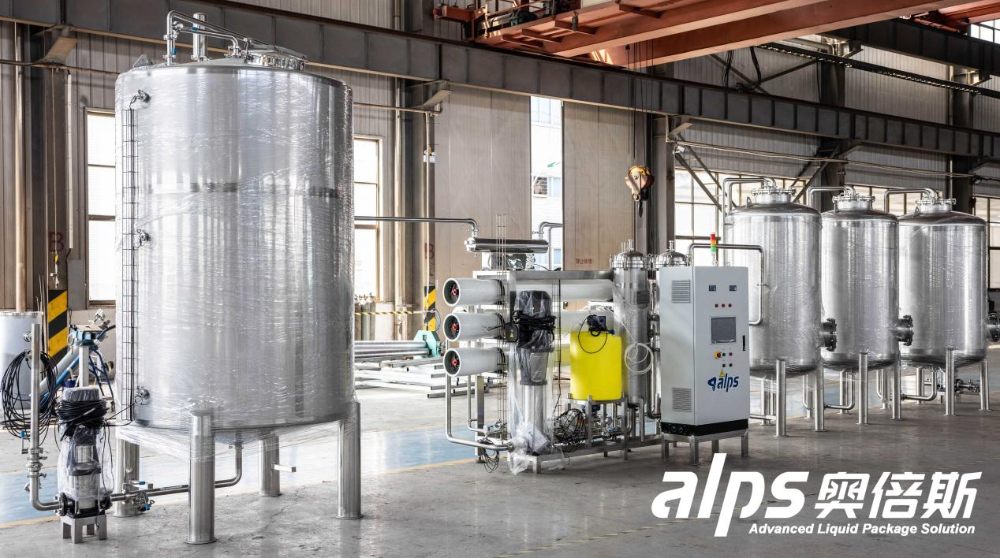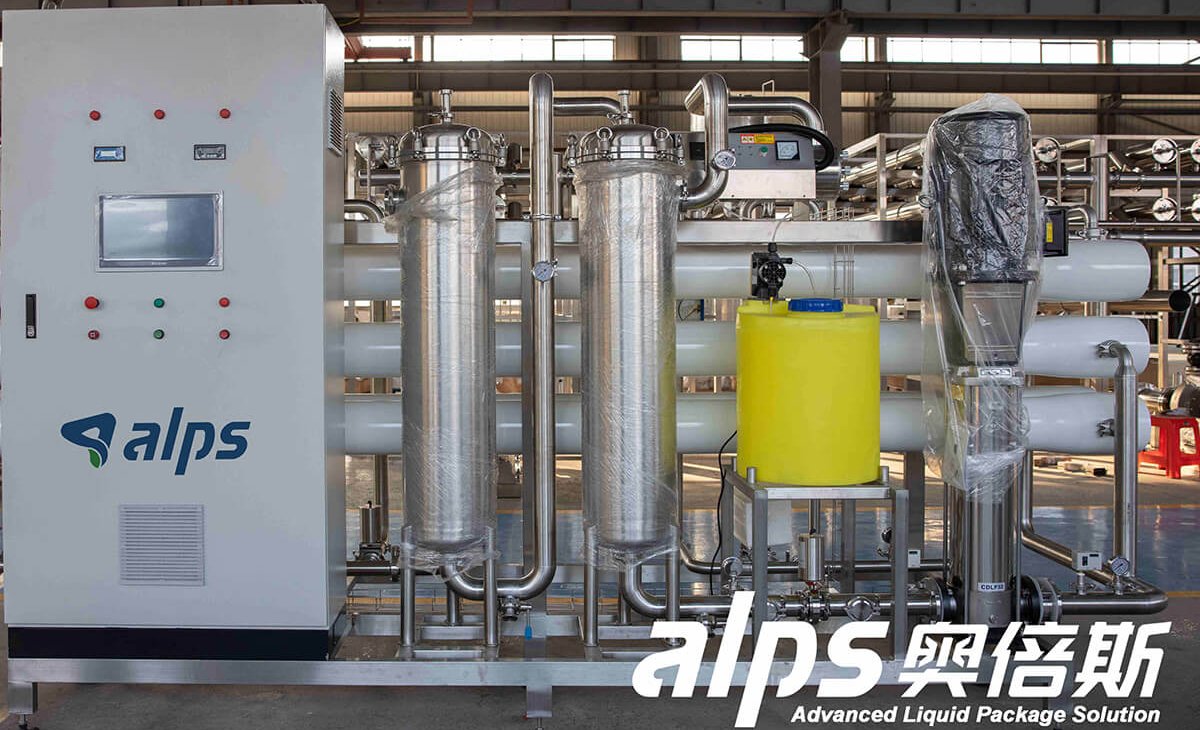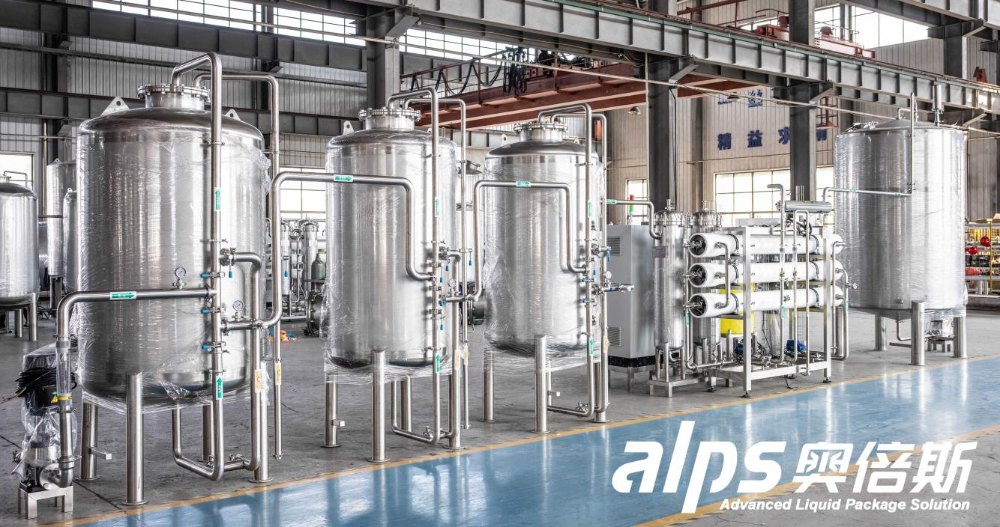Advanced Liquid Package Solution
In the bottled water production industry, maintaining high water quality standards is not just a regulatory requirement—it's the foundation of product safety, consistency, and brand trust. At the heart of this process is the industrial water treatment system, which ensures that water used in filling lines meets or exceeds national and international standards.
The water treatment machine supplied by Alps Machine is used for the water filtration and purification processing, suitable for borehole water, deep well water, seawater, medical-use water, salt water, and brackish water. Each system is custom-designed based on the customer’s water source and quality report, using advanced PLC automatic control systems, internationally recognized filtration membrane brands, and online water quality monitoring. The produced water consistently complies with National Drinking Water Quality Standards and WHO Drinking Water Guidelines. With such precision systems in place, maintaining and upgrading them becomes crucial to long-term production efficiency and water quality assurance.

Before diving into maintenance and upgrades, it’s important to understand the major components of a water treatment system for bottled water production:
Pretreatment Units: These include multimedia sand filters and activated carbon filters, which remove sediments, chlorine, and organic matter from raw water.
Reverse Osmosis (RO) Systems: RO is the core filtration process that eliminates dissolved salts, heavy metals, and bacteria, producing high-purity water.
UV Sterilization and Ozone Disinfection: These processes neutralize any remaining microorganisms before the water enters the bottling line.

Storage and Distribution Tanks: These hold purified water and ensure a consistent supply to the filling equipment.
Control Systems and Sensors: Automated PLC systems and real-time water quality monitors keep operations stable and alert operators to abnormalities.
Proper maintenance ensures your water treatment system operates at peak efficiency and avoids costly downtime. Here are key practices to keep systems in optimal condition:
Routine inspections—weekly, monthly, and quarterly—should focus on critical checkpoints like:
Filter pressure differentials
RO membrane pressure and flow
Water quality indicators (TDS, pH, turbidity)
Pump performance and electrical components
Keeping a checklist and schedule can help you catch minor issues before they escalate.
Pretreatment filters like multimedia sand or carbon beds must be backwashed regularly. Cartridge and membrane filters, particularly in the RO stage, need timely replacement based on hours of operation or water quality readings.
Carbon Filters: Typically replaced every 6–12 months
RO Membranes: Replaced every 1–2 years depending on water quality and usage
Pre-filters (PP/UF): Replaced monthly or quarterly
Regular checks of total dissolved solids (TDS), pH, microbial count, and conductivity ensure the treated water is within safe bottling limits. Smart sensors and online monitoring systems help automate this task and provide instant alerts for anomalies.
Cleaning-in-Place (CIP) is essential for pipes, tanks, and membranes to avoid bacterial buildup. UV lamps and ozone generators also require cleaning and occasional bulb or part replacements to retain disinfection effectiveness.
Even with consistent maintenance, every system will eventually face limitations due to technology aging, capacity demands, or regulatory changes. Signs that it’s time for an upgrade include:
Reduced flow rates or declining system pressure
Frequent component failures or rising energy consumption
Failure to meet newer regulations for drinking water standards
Increased production needs exceeding current capacity
Incompatibility with new digital monitoring systems
Ignoring these signs can lead to system inefficiencies, contamination risks, or production bottlenecks.
Modernizing your water treatment system not only boosts performance but also improves energy efficiency, reduces labor costs, and enhances compliance. Here are some popular upgrade paths:
Install high-efficiency membranes with improved recovery rates (up to 85%)
Integrate energy recovery devices to lower operating costs
Optimize chemical dosing and CIP routines for better membrane longevity

Digital transformation brings a new level of control and insight:
Install PLC-based automation systems with touchscreen HMIs
Add remote access capabilities for 24/7 monitoring and diagnostics
Use predictive maintenance software to forecast filter replacements or component wear
Expand your system with:
Extra UV or ozone stages for higher disinfection confidence
Additional filtration units to address changes in raw water conditions
Polishing filters to further enhance taste and clarity
Install traceability features like data logging and QR code tagging
Upgrade to meet ISO, HACCP, or GMP standards for export readiness
Ensure alignment with evolving local or international bottled water regulations
A long-lasting water treatment system is not just about high-quality components—it’s about effective operation and planning. Adopt these best practices to extend system life:
Partner with a reliable equipment provider who offers tailored designs and full technical support
Train staff on both daily operations and emergency troubleshooting
Establish a preventative maintenance calendar and document all interventions
Stock critical spare parts on-site for fast replacement during production
Perform annual performance audits to benchmark efficiency and detect degradation
In the competitive world of bottled water production, maintaining the highest water quality is non-negotiable. A well-maintained and strategically upgraded industrial water treatment system ensures consistent output, regulatory compliance, and reduced operational costs. It also enhances the reputation and reliability of your bottled water brand in the market.
Whether you’re just starting or already running a high-capacity filling line, periodic evaluation of your water treatment setup is essential. Don’t wait for system failure—plan maintenance proactively and embrace upgrades that future-proof your operations.
Alps Machine is proud to offer advanced, economical, and effective water treatment systems tailored to the specific needs of bottled water production. Our solutions are engineered with international membrane brands, PLC automation, and online water quality monitoring—designed to meet both national standards and World Health Organization guidelines. Contact Alps Machine today to ensure your water treatment line is always one step ahead.

By continuing to use the site you agree to our privacy policy Terms and Conditions.